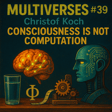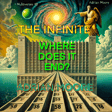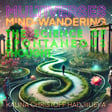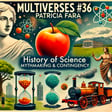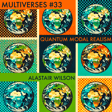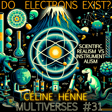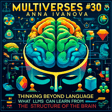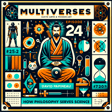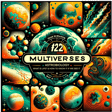Fundamental Questions of Space and Time
00:00:00
Speaker
What sort of things are space and time? Are they fundamental entities, irreducible and irreplaceable in our physics? Or do they emerge from or are otherwise dependent on other elements of nature? These are the questions that we're asking this week and we have perhaps the best person in the world to answer them.
00:00:18
Speaker
Julian Barber is a physicist who spent over six decades thinking about these topics. He's written three books, The Discovery of Dynamics, The End of Time, and The Janus Point. Following the tradition of Leibniz and Mack, Julian's position goes something like this. Space is not a container that exists independently of the objects that it encloses. Rather, it is just a codification of geometric relationships between objects. Similarly, time does not exist independently of change.
00:00:46
Speaker
cannot flow without things happening.
Arrow of Time and Complexity
00:00:49
Speaker
Rather time is a codification of the way that the world changes its shape from now to now, from one moment to the next. More recently Julian has gone on to explore why there is an arrow to time, despite the symmetry of the fundamental physical laws. He gives a very different explanation for this than the one that's usually invoked in terms of entropy,
00:01:12
Speaker
Instead, Julian looks at a new quantity, the complexity, and I think it's really interesting to think about what that quantity means and apply it in different ways. So look out for that. I've been hoping to speak to Julian for decades now, and it's really wonderful to have that opportunity. The only thing I regret is that we do run out of that very elusive thing, time.
Newton vs. Leibniz on Space and Time
00:01:38
Speaker
I'm James Robinson, and this is Multiverses.
00:01:56
Speaker
Jimmy and Robert, thank you so much for joining me.
00:02:00
Speaker
I want to take us back about 300 or so years to a debate which I think has greatly influenced your work between Newton and Leibniz. And I guess Newton thought that he had figured out the nature of time and space based on what he discovered from his dynamical equations. But what did Newton believe about space and time?
00:02:31
Speaker
In his famous Principia published in 1687, he says that time is absolute and it flows independently of anything else in the universe, anything external, like I suppose some river flowing on forever. Now,
00:02:53
Speaker
Newton knew perfectly well that there were various things that measured time and that they so to speak marched in step so that you could have confidence in them. So first of all there's the sidereal time which is
00:03:11
Speaker
goes back to the rotation of the Earth relative to the stars. But then he knew that a few years before he published The Principia, the astronomer Royal Flamsteed at Greenwich had confirmed that the recently invented pendulum clocks
00:03:28
Speaker
keep the same time as the rotation of the Earth, but they don't keep neither the rotation of the Earth nor the pendulum clocks keep time with solar time because the Sun doesn't move around the ecliptic uniformly. So he was aware of that
00:03:48
Speaker
He also, and what he could have said, which is basically what I say in a recent book, Frank Vilcek, the Nobel Prize winner, has said that the striking thing about the universe is that there are many processes which you can use as clocks and they all march in step with each other. And in fact,
00:04:13
Speaker
That's how time is determined, UTC, the time standard for the whole world, really goes back to over 100, I think it is in total atomic clocks. And it's the average that counts, not any one individual one, because each individual clock has hitches, it glitches.
00:04:35
Speaker
And so that underlies that principle. So basically Newton knew that, but I don't know quite why he went for absolute time. He could just have said, well, there are processes in the universe which give us a good time. He says it may well be that there is no
00:04:57
Speaker
process, no motion in the universe, which does give perfect time.
Newton's Absolute Space and Motion
00:05:03
Speaker
He does say that. Of course, what he drew attention to was only a proximate agreement because it's always experimental. I think his ideal for time was just he wanted to have something that was perfect and mathematical. He's very keen on, he wants to match the marvellous
00:05:25
Speaker
accuracy of Euclidean geometry. He wants to be as good as a top-class geometer, and he makes that quite clear in his Principian. So that's what he has to say about time. About space, we know much more about why he said what he did about absolute space,
00:05:46
Speaker
because that was uncovered in an unpublished paper of Newton called, the opening words are de gravitatione, and that includes a very detailed discussion by Newton on Descartes' ideas about motion. So Descartes had introduced the
00:06:14
Speaker
idea of the mechanical notion of physics, that the world is made up of material objects which are sort of all bumping into each other because they're in a plenum. Descartes originally then, Descartes was the first person to formulate laws of nature, of motion of these objects, and his first two laws
00:06:42
Speaker
The first law was actually any piece of matter that is in motion will keep the speed it has forever until it bumps into something else. And secondly, if it's not bumping into anything else, it will go in a straight line. And this just presupposes that's exactly Newton's first law, and it presupposes Newton's ideas of absolute space and time. And this was
00:07:10
Speaker
This was 50 years before Newton published his Principia. And Descartes was just about to publish his whole idea in a book called The World, Le Monde, in 1632, when he heard about Galileo's being condemned by the Inquisition.
00:07:33
Speaker
Now, this was a real problem for Descartes because he had accepted the Copernican principle that the earth goes round the sun and moreover that there are other suns around which planets go and Giordano Bruno
00:07:54
Speaker
Yes, in 1600 for espousing those ideas, among others, I think. And Galileo had been put under house arrest in 1632. So Galileo, Descartes didn't want that fate. So he suppressed his book and thought hard what he could do. And then
00:08:17
Speaker
Twelve years later, he published his magnum opus, The Principles of Philosophy.
00:08:26
Speaker
And in the Principles of Philosophy, it starts with something which was not at all present in Le Monde. It starts with a lengthy discussion of motion. And he has two notions of what position and motion are. He says the position of an object is determined by the thing that's immediately surrounding it. So if I'm wearing a glove, my position is the glove.
00:08:53
Speaker
or the position of my left hand is my right hand or of my right hand is my left hand. So that actually goes right back to Aristotle, that idea. Then he said there was a second possibility for defining motion. That was the motion of anybody in the universe relative to all the other infinitely many bodies in the universe.
00:09:17
Speaker
And in both of those cases, he was safe from condemnation from the inquisition because he assumed that the earth was being carried around the sun by a vortex and the position of the earth was defined by the vortex in which it's sitting. The earth is not moving relative to the vortex in which it's immediately adjacent to it. So the earth is not moving by that definition of motion. And also,
00:09:46
Speaker
given that there are infinitely many bodies in the universe all moving in different ways, there's no way there's a definite motion for the Earth to define. So one way or the other, he was safe. But then, having done all that, he then announces his laws of motion, which are completely unchanged from Le Monde and presuppose absolute space and time. Now, when Newton read this sometime about
00:10:17
Speaker
It's unknown when Newton read it, but later than 1668 and certainly some years before he published the Principia, he just said, this man is nuts. He's crazy. How on earth can he talk about straight lines in this thing where he's just defined motion in that way? And then very significantly, I think,
00:10:43
Speaker
He introduces what since then has been called the notion of equilocality. Equilocality, as it was defined by the German relativist Jürgen Ehlers, and I think it's a very good word, means
00:11:04
Speaker
If everything is moving relative to each other, how can you say at this moment of time that this particular point is the same point that it was at an earlier instant of time?
00:11:20
Speaker
Newton formulates that quite clearly in his De gravitatione and says it's impossible because that earlier instant of time no longer exists. It's impossible to identify in this instant of time which point was a previous point.
00:11:40
Speaker
And that is clearly why that combined with his desire to rival the exactitude or exactness perhaps I should say of geometry is why he wanted to introduce absolute space so that he can talk about straight lines because he was well aware of the value of the law of inertia which was already sort of floating around Galileo had pretty well said it and so forth.
00:12:11
Speaker
So that was really why he did it. But then when he came to publish the Principia, there's a famous scolium at the start of it where he lays out these definitions of absolute space and time and justifies them. Now, what very few people have realized is that when he wrote that scolium, he had two aims in mind. One was a very serious one, which was
00:12:40
Speaker
the problem of defining motion if everything is moving relative to each other. And to justify the introduction of absolute space. But the other one was to make a fool of that Frenchman Descartes, who he saw as his great rival to establish his name in posterity. And he doesn't mention Descartes. He doesn't openly disagree with Descartes in that Principia.
Mach and Einstein's Influence
00:13:09
Speaker
but he's clearly got him in his sights and there's all sorts of evidence for that. And that had, we can perhaps go on to that, but it had rather a positive side effect. Well, I might as well just mention it. So in the Scolium, in the Principia,
00:13:33
Speaker
Newton has his famous bucket experiment. In the bucket experiment, he starts off with a bucket hanging from the ceiling by rope, which has been twisted round. The bucket is full of water and the level of water is level.
00:13:53
Speaker
And then he lets the bucket loose so that it can start spinning as the rope unwinds. And as it does so, the motion of the bucket is transmitted to the water. And bit by bit, the water rises up the sides of the bucket. And when it's reached the maximum height it does, there's no motion between the water and the wall of the bucket. So he says, this shows that this
00:14:20
Speaker
centrifugal force, this tendency from the centre, is in no way due to relative motion. It must be due to motion relative to absolute space. Well, when Mach read that nearly 200 years later,
00:14:41
Speaker
I'm quite unaware of the Cartesian background with Descartes. He just said, well, that's ridiculous to think the thin walls of the bucket could do that. Nobody can say what would happen if the walls of the bucket were thicker and thicker until they were ultimately several leagues thick.
00:15:05
Speaker
And I think that must have been, I haven't managed to check it out. I haven't got round to trying to look at everything that Einstein wrote about it. But I'm pretty certain that remark of Mach was what made this idea of relative motion so plausible to Einstein. And so I think we may well owe general relativity to Einstein.
00:15:30
Speaker
Descartes trying to escape the problems with the Inquisition. I would say it is a serious thing because Mach himself said,
00:15:49
Speaker
It is very important to study the history of science, how it develops, because when you do that, you see that a lot of science which now appears to be indubitably true
00:16:03
Speaker
and cannot be challenged is actually contingent and to a large extent accidental. So I think we might say that the discovery of general relativity is accidental. And I would say this has affected the form that it takes because I think although I don't think there's any evidence to challenge the physical predictions that follow from general relativity,
00:16:34
Speaker
I do think the form in which it's represented may well be hindering further discoveries, in particular
00:16:45
Speaker
clarifying whether there is any quantum gravity, and if so, what form it should take. Because a critical part of the development of general relativity was the introduction of the notion of space time by Minkowski. And Minkowski, if you read Minkowski's paper from 1908, there isn't a trace of Leibnizian or Machian intuition by it.
00:17:15
Speaker
So I would say, and in general relativity, as Einstein formulated, he said it must be that locally, space-time is Minkowski and space and time are knit together in that way. So I would say that that's not really what
00:17:33
Speaker
The mockin ideal should be to recover all the observational predictions of general relativity, but to explain why a space-time or that structure of Einstein's takes the form it does.
00:17:50
Speaker
that's how I think about it. So we've rushed on rather ahead. So I suppose we should go back to that. We've moved on about 300 and three, well, 250 years or so. And we still have another 50 years or 100 years from general relativity to now. But I think you're right, we should maybe just recap where we've got to. And I think it's, you know, the bucket experiment in particular, I think is is an interesting one to go over. But if we summarize
00:18:19
Speaker
motivations for Newton or his arguments for why space
00:18:24
Speaker
and time were these fundamental, in his view, objects, elements of reality. As you mentioned at the beginning, time for him, you know, I think the argument's pretty weak, but he was suggesting, well, there's all these processes going on which seem to be measuring off something common. And therefore, perhaps there's some almost platonic ideal behind this that is being reflected in all these processes.
00:18:54
Speaker
And space, as you say, he has a somewhat stronger basis or necessity for saying that there is absolute space, because if you want to define what a straight line is, if you want to define inertial motion, for Newton, the way of doing that was to say, well, it's moving against this invisible fabric, which you so beautifully call a kind of a giant block of ice. But
00:19:24
Speaker
I think Leibniz had pretty good rejoinders to those arguments. And there's this wonderful debate between Leibniz and Samuel Clark, who is always described as a kind of disciple of Newton, as if Newton is this messianic figure, which maybe he thought of himself as. And in that debate, I think Leibniz keeps on
00:19:48
Speaker
I find that Clarke is on the ropes for most of it. And Leibniz has very good arguments about why say that something is moving against absolute space and then straight lines when we can say that its motion is relative to other things. But then Clarke's really good argument comes back to the bucket and saying, well, I have this bucket that's spinning round. There's water in it.
00:20:19
Speaker
as it starts to spin, that water starts to curve. At first, the water is spinning relative to the walls of the bucket, so you might say, oh, well, it's caused by the relative motion, as you were saying. But then it reaches a steady state where the bucket is spinning, the water is spinning, and the surface is still curved. And Newton and Clark say, well, this is,
00:20:44
Speaker
What you're moving against is that fabric of space, that ice, as you put it.
00:20:56
Speaker
Newton is quite an effective argument, I think partly because Newton didn't like the idea of action at a distance, which he did admit into his theory. It's in there in the inverse square law of gravitational attraction, but he clearly didn't like that. He always famously said, I frame no hypotheses for how that works. I get the impression somewhat that Leibniz wasn't too keen on action at a distance either, because the
00:21:26
Speaker
If you had been happier to introduce that, I feel that the Machian principle would have been more obvious to him. And then as you say, hundreds of years later, Matt comes back and says, well, no, yeah, it is moving rather. What about all those stars all over the place, all the matter that's in the universe? Maybe that has something to do with that relative motion.
00:21:55
Speaker
I think we should mention here that this is something that
00:22:00
Speaker
I would say it's been quite well put to bed by the work that you did with collaborators on reformulating Newtonian mechanics. So as to remove this need to define your motions relative to something that's independent of objects themselves, to put it all in relative terms.
00:22:27
Speaker
perhaps you can talk a little bit about that as I feel that's a real win. It says live nets I think would be happy with that result. Yes, well thank you. I think it is a definite advance but there is an issue which is
00:22:49
Speaker
occupying me more and more now is that that work that I did, the first breakthrough was with my Italian collaborator Bruno Bertotti, and then from about 1999, I was working a lot with other people as well, was that the main striking model with Bertotti was for a finite number of particles.
Barber's Best Matching Theory
00:23:18
Speaker
Basically, the way I just describe it is if there are only three particles in the universe, they would form a triangle at any instant.
00:23:30
Speaker
And then at a later instant, the size and shape of that triangle, if we allow that there is some ruler outside the universe which tells the size, which is an issue which also needs to be addressed, but let's accept it for the moment. So at an earlier or a later instant, the size of the triangle would be somewhat different, its shape and size would have changed.
00:23:55
Speaker
So basically, the idea that Bertotti and I developed, which I now call best matching, but originally we called it the intrinsic derivative, is to suppose that you could just lay those two triangles on top of each other and move them relative to each other until you'd changed the
00:24:19
Speaker
you'd reduce the apparent change to an absolute minimum. So you can't bring them to exact congruence. You can't lay one exactly on top of the other because they're incongruent, they've changed. But you can bring them so that you have particle one at one vertex and it will have appeared to have moved a certain distance. So you take that distance and square it and multiply by the mass of that particle and you do the same for all of the particles.
00:24:45
Speaker
you add up the whole lot and you take the square root. Well, you can call that the distance between those two particles, those two triangles, sorry. And then you can, so I call that best matching. And it's related to a very fundamental property in mathematics related to group theory. It is using group theory. And then you can say that really you should think of, there isn't any time at all really, there's just
00:25:15
Speaker
a landscape, a space of all possible triangles in the simplest non-trivial case, and say that really the history of the universe is just a continuous curve in the space of all possible triangles. And that's a geodesic, then you have a geodesic principle. And that's essentially what Bertotti and I did. And then you can, so then
00:25:42
Speaker
There isn't really any time, so history is not a bright spot of light moving along that curve in the space of all possible triangles.
00:25:56
Speaker
history is just the path itself. It is just the path. But what we showed is that you can introduce a special way of labeling the points along the path, which when you do that, you find that the universe is evolving in accordance with Newton's law.
00:26:17
Speaker
And the simplest one you get is that the energy, the total energy is exactly zero. And also the key thing is the angular momentum is exactly zero. So what you've done then is make the Newtonian theory much more predictive because you cut out a huge number of solutions. And at the same time, you've met your intuition, to use Poincare's phrase,
00:26:46
Speaker
a result that would satisfy the mind, the mind of a philosopher, as Poincare would put it. So I think that is a good result, but it is important in that that you can only do it if there's a finite number of particles. Right. Yeah, I want to dwell on that just a little longer, because as you say, I think
00:27:10
Speaker
the fact that it requires the angular momentum to be zero. So for instance, if we discovered, if we believed we were living in a Newtonian world, let's just suppose that, but we found that everything had some
00:27:25
Speaker
everything seemed to be spinning. Like the whole universe seemed to be spinning. There was some measurement we could do, which just suggested there was a non-vanishing angular momentum to everything. That would sort of rule out the theory, right? If we discovered the fixed stars weren't fixed, then, you know, I think Newton's argument would more or less stand that there's, there appears to be some fabric against which everything is moving.
00:27:51
Speaker
The fact that we don't see that, if one thinks of this in kind of Bayesian terms, you want to take the theory that is more parsimonious in its predictions is the one that you want to give preference to. And that is this theory that introduces shape, best matching.
00:28:17
Speaker
And I would also point listeners to, I think it's just, this is really well expressed in your book, The Janus Point, but particularly people who have studied some physics. There's been this kind of tradition where one begins, I guess, at secondary school and learns Newton's three laws as three laws. And then there's a reformulation in terms of Lagrangian mechanics and Hamiltonian mechanics where you have a kind of richer way of
00:28:47
Speaker
of applying Newtonian mechanics. And what's really striking about best matching is that it looks exactly the same, right? The form of the equations look exactly the same as what you're getting out of Hamiltonian mechanics. But you just have to do the best matching first. You have to be able to associate each point
00:29:16
Speaker
as you say, arrange those triangles so there is minimal difference between them. And it also only works or only recovers the same predictions in the case that your angular momentum is zero. So when one looks at the equations, it doesn't feel like you've had to
00:29:36
Speaker
Obviously, a lot of work's gone in, but it doesn't feel contrived, is what I mean to say. It's simple in many senses. Yeah, if I can come in. I think that that's true. There's a very nice thing. So Leibniz has what he calls the principle of the identity of indiscernibles. And in the correspondence with Clark, he makes the point which many, many people have recognized the strength of, that he said that
00:30:01
Speaker
If position is defined by distance from other bodies, if you move all the bodies through absolute, through Newton's imagined absolute space, or you turn east, turn them, rotate them and things like that, nothing observable with change. And therefore you have to say, those two situations are exactly the same. Now, it's quite striking that
00:30:30
Speaker
In saying that those situations are exactly the same, Leibniz was anticipating group theory, the theory of group transformations and their interpretation. That was brought home to me when I read a paper by Hermann Weil, a great mathematician, in about 1930, where he said that
00:30:53
Speaker
Leibniz had anticipated the interpretation of group theory there. So group theory is really very fundamental. One can almost say the facts of group theory are embodied in us. Just when we walk and
00:31:11
Speaker
turn around and things like that. We're actually making group transformations and we see the effect of what we can see. So that's fine, I think. That's support. That's why it all goes through so smoothly, I would say. Although conceptually Leibniz is
00:31:35
Speaker
generally felt to have had the better arguments with Clark. When push came to shove, he failed because when the challenge came, how do you define motion when all the bodies are moving relative to each other?
00:31:51
Speaker
whether it's an infinite number or a finite number. And he said, well, then suppose that a large number of bodies or a fixed number of bodies don't change the positions relative to each other, then we can use them as the reference for defining the motion of the remaining one. So that he failed there miserably, one has to say, Leibniz. And I think that's the main reason why he ultimately lost the debate.
00:32:21
Speaker
But that's the problem we solve with best matching. So what we're doing, so we're actually using Leibniz's group transformations, which he implicitly assumed 150 years before group theory was developed. So instead of imagining that we're moving one fixed set of bodies through absolute space,
00:32:50
Speaker
we're imagining that we're moving the same bodies, but in a slightly different configuration relative to an earlier one. So we've got two, at two instants, we have two configurations which are not the same, and we're using those group transformations not to move one relative to different positions in absolute space,
00:33:15
Speaker
but relative to the other one, the earlier, if you call it the earlier configuration or the later configuration. So it's moving two things relative to each other. So you would be changing something which is observable. So if you were God doing this best matching of moving one next to each other, you would see the result and you would see when they're best matched.
00:33:40
Speaker
Yeah, and of course, around the problem. And if everything is, if the entire universe is revolving,
00:33:50
Speaker
the shape best matches onto itself, so that it comes back to the identity of Indiscernible's Leibniz's principle, and there's just nothing to say there. Yes, when you've got those two triangles in the best match position, you can imagine them anywhere in absolute space, or moving around anywhere in absolute space, it will not make one iota of difference to the observable facts.
00:34:15
Speaker
And that's called background, I mean, one of the holy grails of quantum gravity is to achieve what's called background independence. Well, best matching is guaranteed to do that. And what you do get out, of course, is when you extend it to a large number of particles, and obviously you can't do it for an infinite number, as you mentioned, but you do recreate the angular momentum between
00:34:41
Speaker
sets of particles that are moving, so if you have a kind of large configuration of masses and among those some are rotating around each other, sort of like solar systems, their angular momentum will be felt and it's the result of
00:35:00
Speaker
the influence of all the other particles creating a kind of fixed geometric background almost. Yeah, that's very nice. Yeah, if I can come in, it that's very nice. And it's a very wonderful feature of Newtonian theory, which I don't think has been recognized at all. Because as I explained in the Janus point, you can have situations where the particles have a
00:35:27
Speaker
more or less uniform distribution and a random directions of their motions. But then as it evolves in both directions of Newtonian time, clusters form and all those clusters can, as you say, have different values of the angular momentum and energy. The only thing is it must all add up to zero, the total must be zero. And that's
00:35:54
Speaker
That's really, I think, very satisfying. It shows that the universe is holistic and also, I would say that
00:36:03
Speaker
what we regard as local laws of nature are emergent. So the whole universe satisfies what is called constrained Hamiltonian dynamics. That's because the energy and the angular momentum are exactly zero. That's what's called constrained Hamiltonian dynamics. So the universe has one single entity is constrained. But then when these subsystems form, they then satisfy Hamiltonian dynamics because the energy and the angular momentum
00:36:32
Speaker
in each of them can have arbitrary values subject to that very important proviso that the total is zero. It's quite remarkable. Just to finish, so the local laws of nature are emergent out of a holistic law of the whole universe. Yeah.
00:36:50
Speaker
Yeah, it explains also something that others may have been wondered about, which is why is the inertial mass the same as the gravitational mass, or at least gives a very strong feeling for why that is. Because a priori, there's no reason why the attraction between, you know, the gravitational attraction between two masses
00:37:17
Speaker
should be the same number, the same property as the inertial mass. They're performing quite different functions. Whereas that just fits very nicely within this framework. There's just one kind of mass and the
00:37:44
Speaker
Well, it is nice, but I wouldn't say it's necessary. I'd say it's agreeable, but not necessary. And of course, you do have electromagnetic interactions, which are different. I would say it's an agreeable feature, but clearly, it needn't have been that way. I think you can do best matching under all circumstances.
00:38:11
Speaker
I wanna move on and talk to something slightly different and get to the Louisville theorem, which was for me, one of the most remarkable chapters in your book, The Janus Point, where you start thinking about the direction of time and how that's related to, maybe we need to wind back a little bit and first talk about a particular way that you can characterize
Complexity and Time's Arrow
00:38:43
Speaker
So we've talked about best matching. You have this notion, complexity, which has a really interesting kind of status within relationships to the gravitational potential.
00:39:02
Speaker
Perhaps talk us through what is complexity? In fact, what got you started thinking about complexity in the first place? Well, first of all, this absolutely definitely goes back to Leibniz. I read Leibniz, a very nice collection of Leibniz's philosophical papers in 1977, and I was very
00:39:28
Speaker
impressed by the fact Leibniz, what you get from that is that Leibniz says it's a very simple obvious fact that if there were no variety in the world that there just wouldn't be any science, we couldn't do anything without variety. That is the sort of the epistemic foundation of everything, of science, of existence, of everything, it's variety. And then Leibniz
00:39:55
Speaker
believed as a metaphysical principle in perfection, that God would strive to make things as perfect as possible. So you can interpret Leibniz as saying, well, one way of interpreting what he says is that the universe is striving to become ever more perfect. But actually, in the Monadology, he says that we are in a universe which is more varied than any other. Well, that's what I
00:40:25
Speaker
believed for quite a long time and developed that idea with Lee Smolin. But after about 10 years, I began to feel that the way that Lee had produced a very interesting mathematical way of realizing Leibniz's idea
00:40:41
Speaker
was actually not going to get really much further. But I always had at the back of my mind something that would characterize variety. Through meeting specialists in the Newtonian end body problem,
00:41:00
Speaker
There's a relatively small number of very top class mathematicians who work on developing Newton's theory of gravity. I mean, cosmologists are using Newton. I mean, lots of people are using Newton in gravity all the time.
00:41:14
Speaker
But just a small number of them, as I say, perhaps 20 or 30, really concentrated on really the fundamental mathematics that really is the guts of the theory. And that's very, very interesting. Very few people know about it.
00:41:33
Speaker
All of this is to do with the fact that it's ridiculous to assume that there's a ruler outside the universe. There's a problem of what do you mean by changing the size of the universe overall. In fact, Poincare, the great French mathematician, says
00:41:50
Speaker
imagines that everything in the universe changes overnight, gets a thousand times greater. But he says it's ridiculous. Within the universe, you wouldn't notice anything. It's an assumption. Really, when you think that way, you're assuming that there's a ruler outside the universe. So there can't be a ruler outside the universe. So
00:42:12
Speaker
Now this is where group theory comes in also very, very fundamentally because the Newton gravitational potential. So from the Newton gravitational potential, which is a one upon R potential, you get the famous inverse square law, which is one upon R squared. But the Newton potential, which is really, I suppose you could call it the motor of Newton's theory of gravity,
00:42:42
Speaker
because it depends upon the separations between the particles, which means that if you move all the particles or you rotate them all, that's doing a Leibnizian
00:43:00
Speaker
move, it doesn't change the value of the Newton potential. However, if you change the scale, if you enlarge all the separations, the Newton potential goes down in value. So the Newton potential is not invariant under dilatations, it's not scale invariant.
00:43:22
Speaker
But you can change it to something which the people who work on Newton's theory at this really fundamental level call the shape potential or the normalized Newton potential. And it is that the Newton potential made scale invariant, you multiply it by what's called the root mean square length. So the root means square length. So you've got these separations between the particles.
00:43:51
Speaker
You square all of those separations, you multiply, so you've got
00:43:58
Speaker
R12 between particle one and particle two. You square that, you multiply by the mass of particle one and the mass of particle two, and then you add that up for all the particles, and then you take the square root. And that's the root mean square length. And that changes with the length. So now if you multiply the Newton potential
00:44:22
Speaker
by the root mean square length, you've got the two factors. One of them increases if you increase the lengths and the other decreases. So the effect is cancelled out. So if you just moved everything further apart, there'd be no difference. That's the scale invariance. So that's the scale invariance, yes. And so you've achieved something. Now,
00:44:51
Speaker
What is very interesting, and this is sort of really only fully dawned on me, I hadn't even fully dawned on me when I wrote the Janus point, or Janus point, I choose your pronunciation, is that the
00:45:12
Speaker
Newton potential. So there's actually two fundamental, if you talk to mathematicians about points distributed in Euclidean space, forget that they have mass, they're just points in Euclidean space. There's two obvious lengths associated with that distribution. One of them is what I've already described, the root mean square length. The other one is what is called the mean harmonic length.
00:45:40
Speaker
Now, very interestingly, the mean harmonic length is the inverse of the Newton potential. And so that shape potential or the complexity, as we call it, is the ratio of those two things. Now, for me, the complexity is, I would say for me, it's absolutely fascinating quantity. So first of all,
00:46:09
Speaker
if it's a measure of variety or of complexity, that's why we call it complexity. Because if you've got, say, 20 particles, and you move two or three of them close to each other, or you even bring them to coincidence, the root mean square length hardly changes. But the mean harmonic length gets much, much smaller.
00:46:34
Speaker
because it's the inverse of the Newton potential. So the Newton potential gets huge if you bring particles close to each other. And so what that means is that the shape potential is a very sensitive measure of clustering or variety. It was when I was beginning to get aware of that, I was talking to one of these Newtonian specialists at the Observatory in Paris about that.
00:47:05
Speaker
I think it was 2011 and saying, could this shape potential be a good measure of variety?
00:47:12
Speaker
And that was key to get that insight. So that's one thing. But then the other thing is that you can call it a dimensionless radius of this distribution of particles because the mean harmonic length is more or less the average of the large separations. And the mean harmonic length is the average of the short separations.
00:47:36
Speaker
Now, when you measure an interval, a longish interval, you take a short ruler to measure it. So if you want to say, how would beings, observers within such a universe defined by these points, how would they measure its size? Well, they would see how many times the mean harmonic length goes into the root mean square length. And they would call that the radius of their universe.
00:48:07
Speaker
So that has a minimum value. When the universe is more uniform than any other distribution that it can have, that quantity has its minimum. And then as it clusters, it just goes on getting bigger and bigger. Yeah. Yeah.
00:48:26
Speaker
And that then, that then led to the paper that my two collaborators, Tim Kozlowski and Flavio Naccati, were able to publish in 2014, about two years after I'd had that discussion at the Observatory in Paris, where we find an alternative explanation of the arrow of time, which is nothing whatever to do with entropy. So ever since
00:48:53
Speaker
the discovery of thermodynamics, it was thought that the universe must end in a heat death where all differences are evened out.
00:49:10
Speaker
And things would come to an end. And then Clausius developed the notion of entropy and said that, which has since become characterized as a measure of disorder. And Clausius then, in 1865, he coined the expression entropy, and he then very proudly formulated two laws of the universe. The energy of the universe is constant.
00:49:40
Speaker
entropy of the universe tends to a maximum. So ever since then, particularly since a famous debate between Boltzmann and Zermelo in 1895-96 period, it's been assumed
00:49:57
Speaker
that entropy is what gives rise to the direction of time that we experience and in the universe. That's defined by an increase in entropy. Moreover, it's a statistical effect. If you look at the laws of nature, it's not to be found in a single solution. It's in what's called the way
00:50:23
Speaker
the Gibbs distribution evolves in accordance with Liouville's theorem. It spreads out all over the place in accordance with Liouville's theorem. So that's the way that people do it. So as I said, the key thing is the increase of entropy is not in an individual solution. Now, in the Newtonian N-body problem, if the energy is non-negative, which it
00:50:50
Speaker
Jolly well better be if the universe is mocking.
00:50:53
Speaker
There's always a special point on the timeline of the universe that I call the Janus point because at it in Newtonian terms, the size of the universe is minimal at this point. In the infinite past, it's infinitely great. It decreases monotonically in general to a finite value and then increases again. But the much more significant thing for people inside that universe who can only see how it changes is that at the Janus point,
00:51:22
Speaker
the distribution is more uniform around, at least around the jealous point, the distribution is more uniform than anywhere else. And in both directions away from it, it becomes more clustered and the complexity increases. And the key thing is that happens in every single solution. So this completely transforms the discussion of the origin of the hour of time. And moreover,
00:51:47
Speaker
As that complexity increases in both directions away from the Janus point, these clusters that we've already talked about form
00:51:57
Speaker
And these clusters all have a birth and a death, and their births and deaths, the arrows of the birth from the birth to the death, they all point in the same way. And they all point in the same direction as the increasing complexity. So the increasing complexity is the master arrow of time and reflects the fact that these subsystems are forming. Now,
00:52:23
Speaker
When does thermodynamics hold? Einstein said that thermodynamics was the only physical theory of universal content of which I am convinced that within the proper domain of applicability of its basic concepts will never be overthrown.
00:52:49
Speaker
But people just forget about that caveat. What are the conditions under which thermodynamics hold? Well, thermodynamics came out of the study of steam engines. Steam engines stop if the steam escapes from the cylinder. So basically, you've got to have a system in a box for things like the increase of entropy. And if you then look at the
00:53:16
Speaker
the atomistic explanation that was developed to explain the laws of thermodynamics, in particular the second law of thermodynamics, the increase of entropy, first really seriously by Clausius, then followed by Maxwell, who proposed the Maxwell distribution of velocities or
00:53:40
Speaker
so forth, and then Boltzmann and then Gibbs, they all assume a system in a box. So you have molecules that bounce off each other. But critically, they bounce elastically off the walls of a box, which prevents them escaping. That's right. This isn't just a conceptual box. This is a real box, right? It's not. Well, mathematically, well, first of all, in the laboratory, it is a physical box. That's where all of these things were tested. I mean, the
00:54:10
Speaker
I mean, Maxwell actually did famous tests on viscosity in a box. And in fact, rediscovered something that had Boyle and and hook Robert Hooker discovered 200 years earlier that if you have a pendulum in a in a box, and you evacuate the gas in the box, the period of the pendulum doesn't change.
00:54:38
Speaker
until you get down to incredibly rarefied state in the gas. Maxwell couldn't believe that. That comes out of the mathematics, out of statistical mechanics, amazingly. It's an extraordinary result, which Maxwell couldn't believe. He thought it disproved the atomistic theory. But his mathematics, and then he checked, then he did an experiment with his wife, a famous experiment with his wife, and then confirmed that that was the case. But it had actually been done and forgotten.
00:55:07
Speaker
sort of 200 years earlier by Boyle and Robert Hooke. So the role of the box is critical and without it. And in mathematical terms, it says that you've got a dynamical system whose solutions are only exploring a phase space of bounded Liouville measure.
00:55:30
Speaker
So, you've got two completely different situations, one where the Liouville measure is bounded and the other where it is unbounded. And in the Newtonian N-body problem, it's unbounded. And I suspect that it's also unbounded for the universe at the moment. The universe, its expansion is accelerating according to all the observations.
00:55:53
Speaker
Right, and just to clarify, I think there's a few things we should walk back over here, because this is just really fascinating. We've rushed through this incredibly interesting notion, complexity, or not rushed through, but there's so much to unpack there. And from it, we get the arrow of time and discussing problems with entropy. But just on this boundedness,
00:56:20
Speaker
If you have everything in a box, there's just a finite number of states that you can be in. If your universe is expanding, not bounded number of states, and that changes many things. I want to come back as well to the traditional
00:56:36
Speaker
explanations of the arrow of time, which as you hinted were all entropy based. And one of the unsatisfactory features of those explanations is you only get the arrow of time by adding this past hypothesis as David Albert calls it. You have symmetric laws of physics and what changes things is this kind of boundary condition, the way that things were at the start of the universe. It seems somewhat ad hoc and it would be nice to be able to say
00:57:04
Speaker
why that holds or come up with an alternative explanation. And as you say from the end body problem, the particles can be set down in any configuration and they will pass through this under their gravitational interactions, they will pass through this minimal point. And furthermore, and this is I think where the Leuvel's theorem comes in,
00:57:27
Speaker
and the complexity comes in, as you move away from that point, that minimal point is going to have minimal complexity. And as you move away from that, your complexity increases. And if I understand correctly, it's simply because your complexity is made of this term which describes the overall scale.
00:57:46
Speaker
and this term which describes the shape. And if everything is moving apart from where it was previously, I don't want to say that the universe is getting bigger, but it's expanding from where it was. Louisville's theorem says phase space is kind of a dense fluid. Its volume is preserved as you move through it. So the volume of phase space, I want to say, of that configuration, any configuration, has to say the same as it evolves.
00:58:14
Speaker
the separations are going to be getting larger because everything's expanding. To compensate for that, the other component of the complexity has to change as well. And the way that changes is it's forced to generate more structure. Perhaps you can read that back in a more... Well, I would say there are...
00:58:35
Speaker
one has to, I would say one has to distinguish between what one could call the extended representation. So you can, you can have a representation in which you imagine there is an absolute space with an absolute scale, and you represent in that and then you distinguish between the variables that describe your system in that situation with what are called the physical variables, where
00:59:02
Speaker
you get rid of the extra descriptors, if you like, that Newton introduced. So what you can do is you can take a Newtonian solution, and then you can throw away all the suspect extra structure that Newton introduced. And that will actually just leave you with a succession of shapes.
00:59:26
Speaker
And that's really where the truth resides. And basically the Newtonian solutions, certainly if the energy is non-negative, and the most interesting case is when the energy and the angular momentum are both exactly zero, which is exactly what you do expect in a Leibnitz and Machian situation.
00:59:46
Speaker
then that just has this behavior that there's always a tendency to increase. You can think of the complexity is likely
00:59:58
Speaker
the altitude in a landscape, the height above sea level in a landscape. And there are infinitely high peaks in this landscape where the complexity becomes infinite. So there will be a Janus point somewhere there where the Newtonian size is minimal, but it's actually quite difficult to spot where it is in shape space, but you can spot it. My collaborator Kozlovsky showed
01:00:26
Speaker
precise mathematical condition where the Janus point is in shape space. But as you go away from it, instead of following a geodesic, which is the simplest law you would have,
01:00:37
Speaker
the curve in both directions from the Janus point is just always, it will go back a bit, but it's always trying to climb up these peaks of the complexity.
Gravity and Order from Disorder
01:00:50
Speaker
So, and even if it will go back a bit, it will then keep on the turnaround and it will strive to go up. And this is what I call
01:01:00
Speaker
gravity's creative core. So my interpretation of Newton's theory, it's nothing whatever about, it's not really about what people like Blake, the poet and artist so hated of sort of cogwheels turning and desperately boring and dead really. It's a theory of creation. It's a theory of creation of order out of disorder. And
01:01:32
Speaker
That's the core of the matter. So I recently posted a paper on the archive, Gravity's Creative Core, pointing out this fact. And I think it's just been missed that that's what's going on. I mean, this is, again, the accidental way that science develops.
01:02:02
Speaker
contrast to what we get from the entropic picture, where everything is going to end in this featureless soup, and it comes down to the complexity, and I want to re-emphasise again that
01:02:21
Speaker
you can arrive at the complexity from two different routes. One is, as you said, just thinking purely mathematically about what is a really good way of characterizing clustering and variety. What is something that is minimized when everything is very homogeneously placed versus something that's maximized where you have very interesting, lots of clustered regions.
01:02:51
Speaker
But it also, the complexity also emerges or just matches the Newtonian gravitational potential, which is why you say,
01:03:03
Speaker
lutein in gravity seems to be configured to be the thing that will produce, or sorry, part of the complexity match is that it seems to be configured to be the thing that will produce maximal shape variety. Let me just come in there because one caveat must be made.
01:03:24
Speaker
What it does is it will create structure. In particular, it will create pairs of particles, Kepler pairs, which go around each other and become rods, clocks, and compasses all in one, tremendously well synchronized with each other. But in fact, for a fixed number of particles, in the end,
01:03:49
Speaker
nothing much more will happen. The system gets into what's called limit cycles. So although it's not heat death, the clocks get ever more accurate, but they don't go beyond being clocks. Now somehow or other, this is intimately, I think, related to the problem of infinity, and it's the thing about which I'm thinking a great deal at the moment. So you can
01:04:15
Speaker
It's not unrelated to the idea of a multiverse or many sort of
01:04:24
Speaker
the many worlds interpretation of quantum mechanics, but not in quantum mechanical terms. So you could always say for a given value of n, the number of particles, you would have a different, different solutions, different histories of universes for different numbers of particles. Now, what is interesting is when you see how this evolution happens,
01:04:49
Speaker
much the same thing happens if you've got, starting just with three particles, or if you have an even arbitrarily large number of particles. So basically the same sort of structure happens and possibly outrage it. Now, I mean, I think
01:05:07
Speaker
Infinity is probably the greatest mystery of all in science, and how we really grapple with it, I don't know. But I think it could just be that you could have Newtonian solutions with, say, n equal to a trillion, where there are regions within it which looked like
01:05:32
Speaker
very similar to regions in another solution where you've got a trillion times a trillion particles. There are hints, I think, from that already in the studies that have been done by the chat with whom I'm collaborating. So
01:05:51
Speaker
This would even just might, I mean, this is very hugely sort of conjectural, but I don't think it's any stranger than the many worlds interpretation of quantum mechanics. There might even be sort of an afterlife in which
01:06:12
Speaker
our discussion here is going on in a universe with many more sort of units in it, many more particles within it. It's at least mathematically conceivable, I think. But I really wanted, I throw that, you can almost call it an outrageous suggestion, out as a way to highlight how the, what a huge,
01:06:41
Speaker
literally a huge problem infinity is.
Infinity and Complexity in Physics
01:06:44
Speaker
It's really a very, very big problem, understanding what the implications of infinity are. So all I would say with some degree of confidence is that the hour of time does not have to be
01:07:00
Speaker
explained by adding on to known laws of nature, a very special condition in the past for which there is no obvious reason it should be there. So that I think the fact that we've changed the discussion about the origin of the era of time, I think that's a solid result. I feel pretty confident about that. But what its long-term implications are, I wouldn't like to say. I guess we don't know.
01:07:29
Speaker
what it will mean for the, I mean, one of the questions I have is, do you think there will be consciousness at the end of the universe? And it's almost a corollary of, will this interesting complexity that seems to be producing things, you know, really rich structures like ourselves and the world that we see around us, will the world continue to have that kind of richness? And I guess the answer is,
01:07:58
Speaker
Well, it's hard to speculate. I mean, I think to the extent that the work that I've done with the Newtonian N-body problem is any guide, it's pointing in the direction of, it's something that
01:08:17
Speaker
that would be realized only at infinity. I mean, you can see this already, if you just start with the Newtonian three-body problem, which is the first non-trivial problem, you get something of some interest. But already when you get, you see, when you, I've been collaborating with someone in California who's very good at numerical work. And on his laptop, he started with
01:08:47
Speaker
50 particles near the Janus point, and after a while he devolved it, and he'd got 11 Kepler pairs, two pairs of particles playing around each other, forming ever better clocks, rods and compasses all in one, and in addition he'd got three particles which had formed a pretty stable pair. So this was
01:09:07
Speaker
pretty interesting structure that had been formed. That's much more interesting than can happen with the three-body problem because in the three-body problem, two particles will form a Kepler pair and the other particle as a singleton will go off in the opposite direction to it. So you can immediately see going from three particles to 50 the enrichment. So I would say just increase the number of particles
01:09:35
Speaker
in scientific thermos, increase the possible degrees of freedom and you'll just get ever richer situations. I suspect that may be all that one can say. I'm told by my collaborator Kostnovski that in quantum field theory,
01:09:54
Speaker
Basically, they're always dealing with a finite number of particles, but if the theory is consistent for an arbitrary large number of particles, then that theory is okay. I suspect that at the moment physics can't do any better than that, but I'm not an expert in quantum field theory, so I'm a bit relying on my collaborator when I say that.
01:10:15
Speaker
As I say, this has all come since I finished writing The Janus Point. In that book towards the end of chapter 18, I actually conjecture that complexity does not just determine the direction of time that we experience, but is time itself.
01:10:37
Speaker
And that's all very interesting. And there's, there's at least two talks of mine on podcasts where I'm talking about all the fascinating things that go with that. I was curious as well. Have you tried, how do you measure the, so I've just done something with my, oops, I just did something. Can you hear me okay?
01:11:04
Speaker
I can hear you. Have you tried to measure the complexity of... So one way of looking at things is, like you say, to run simulations and see what emerges. But I'm curious if you've used complexity as a measure of pre-existing things. And one idea that came to my mind was, you know, could we look at the complexity of something like a neural network and artificial intelligence?
01:11:28
Speaker
you know, perhaps the weights between neurons or your masses or something like this, or the complexity of other forms of information. Much as entropy is applied as a measure of information, I think many people find that somewhat
01:11:51
Speaker
unsatisfying in that the maximal capacity of a channel or maximal information seems to be just completely random, which jars with our intuitions, whereas complexity seems like a better measure of those sort of things. And if we have a
01:12:10
Speaker
universe where we know the complexity needs to increase, would that suggest that we, again, get these very interesting structures, if we can say, ah, yes, this structure, the human mind is the most complex thing, much more complex than... What I would... I think this is more just a question of more I would... At the moment, I'm thinking it's a question just of distributions of points in Euclidean space. Now, that is...
01:12:35
Speaker
It's a sort of minimal model of a neural network at a given instant, because all the particles are connected to each other. And they're mutually consistent, all these separations, because there's essentially n squared separations if they're n particles, but you only need 3n minus 7 numbers to define the shape. So then I would say that at a given value of the complexity, the will necessarily, the will
01:13:01
Speaker
be localised regions which are particularly interesting structures. I would liken them to the human brain and the feeling of some sort of awareness and consciousness. This would be a theory of psychomathematical parallelism.
01:13:23
Speaker
But I see we're nearing the end and it's also hot bar six. I don't know whether you've got to go. We could continue this another day if you like. I think probably however many hours we have will never be enough to unravel the mysteries of the universe. That's for sure. We may have to call it here, but I would be delighted to talk to you again.
01:13:49
Speaker
But I think we have enough material to fill mines as it is. Yes. All right. Okay. I think probably it is just now six thirty and you said you needed to probably to be stopping about now. That's right. I have some I think struggling with infinity is an appropriate place to stop.
01:14:09
Speaker
Well, this has just been a wonderful conversation. And as I said, there's so much more I think we could talk about, but I just wanted to thank you for, you know, these are problems you've worked with or on for decades. And I think absolutely fascinating
01:14:29
Speaker
Leibniz Mac would be happy that you are carrying forward the torch. Well, the intuitions for them are strong, that you can say, yes. It's been a real pleasure. Thank you so much. All right. Pleasure. Okay.


